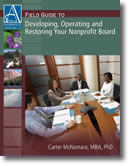Strategic Alliances: Collaborations, Mergers and Acquisitions and Joint Ventures
One of the most powerful means to strengthen an organization’s impact and sustainability
is by engaging in a strategic alliance or combining with other organizations.
There are a variety of ways this can be structured. Organizations face pressure
from funders and investors to efficient collaborate with other organizations.
Mergers and acquisitions are a very prominent strategy, especially among large
businesses. This topic briefly explains collaborations, mergers and acquisitions
and joint ventures.
In their book, Forming Alliances: Working Together to Achieve Mutual Goals,
Hoskins and Angelica define an alliance as a relationship between partners that
is strategically formed to accomplish goals that benefit the community while
strengthening the partners. The authors depict a continuum of alliances that
continues from a very loose relationship to a complete merger.
- Cooperation – Shorter-term informal relationships that exist without
any clearly defined mission, structure, or planning effort.
- Coordination – Longer-term, more formal relationships that rely on
understanding of missions and focus on a specific effort or programs
- Collaboration – Most durable and pervasive relationships where participants
bring separate organizations into a new structure with full commitment and
common mission. (from Winer and Ray’s Collaboration Handbook: Creating,
Sustaining, and Enjoying the Journey)
- Merger – A partnership in which two or more corporations decide to
become one (from LaPiana’s The Nonprofit Mergers Workbook)
NOTE: LaPiana adds more detail to options for partnering and organizes them
into three categories: collaborations, strategic alliances (administrative consolidation
and joint programming, and corporate integration (management service organization,
joint ventures, parent-subsidiaries and mergers).
Bibliography
- Collaboration Handbook: Creating, Sustaining, and Enjoying the Journey
by Michael Winer and Karen Ray. St Paul, MN: Fieldstone Alliance, 1994.
- Forming Alliances: Working Together to Achieve Mutual Goals
by Linda Hoskins and Emil Angelica. St Paul, MN: Fieldstone Alliance, 2005.
- The Nonprofit Mergers Workbook
by David LaPiana. St Paul, MN: Fieldstone Alliance, 2000.
Sections of This Topic Include
Collaborations
Mergers and Acquisitions
Boards and Mergers and Acquisitions
Joint Ventures
Additional Information for Nonprofits
Additional Perspectives on Organizational Alliances
Also consider
Related Library Topics and Recommended Books
Learn More in the Library’s Blogs Related to Organizational Alliances
In addition to the articles on this current page, also see the following blogs
that have posts related to Organizational Alliances. Scan down the blog’s page
to see various posts. Also see the section “Recent Blog Posts” in
the sidebar of the blog or click on “next” near the bottom of a post
in the blog. The blog also links to numerous free related resources.
Library’s
Consulting and Organizational Development Blog
Library’s
Strategic Planning Blog
Collaboration
Resources
Collaboration,
Knowledge Representation and Automatability
For Successful Collaboration, Think Outside the
Box
From Conflict to Collaboration
5
Reasons It Might Be Time to Find a New Business Partner
Partnerships:
Frameworks for Working Together
Mergers and Acquisitions
Basics of Mergers and Acquisitions
Mergers
and Acquisitions — Wikipedias
Merges
and Acquisitions Primer
Merger and Acquisition
5 Tips for Executing a Successful Acquisition
Litigation in Mergers and Acquisitions
The tools – Mergers and Acquisitions
Business Acquisitions and Financing
Does Takeover Activity Cause Managerial Discipline?
Evidence from International M&A Laws
Course 7: Mergers & Acquisitions (Part 1)
Course 7: Mergers & Acquisitions (Part 2)
Mergers and Acquisitions: Understanding the Essentials
of Strategy and Execution in the M&A Ecosystem: Part 1 of
4
Mergers and Acquisitions: Understanding the Essentials
of Strategy and Execution in the M&A Ecosystem: Part 2 of
4
Mergers and Acquisitions: Understanding the Essentials
of Strategy and Execution in the M&A Ecosystem: Part 3 of
4
Mergers and Acquisitions: Understanding the Essentials
of Strategy and Execution in the M&A Ecosystem: Part 4 of
4
Boards and Mergers and Acquisitions
Strategic M&A, Spin-Offs, Hostile Transactions and Private Equity
Litigation in Mergers and Acquisitions
Corporate Governance Structure and Mergers
M&A Litigation: A Potential Partial Solution to a Big Problem
Nonprofit Organization Mergers: What to Do
Joint Ventures
Joint Venture: An Overview
Joint
Ventures (Wikipedia)
Why Joint Ventures?
How to Evaluate a Joint Venture
Nonprofit Information
Nonprofit Mergers and Acquisitions: More Than
a Tool for Tough Times
Partners and Competitors in the Nonprofit Sector
Nonprofit Collaborations: 2.0
Model Guidelines for Nonprofits: Evaluating Proposed Relationships with Other Organizations
Additional Perspectives on Organizational Alliances
15 Steps for Successful Strategic Alliances (and
Marriages)
The tools – Strategic Alliances
For the Category of Organizational Alliances:
To round out your knowledge of this Library topic, you may
want to review some related topics, available from the link below.
Each of the related topics includes free, online resources.
Also, scan the Recommended Books listed below. They have been
selected for their relevance and highly practical nature.
Related
Library Topics
Recommended Books









